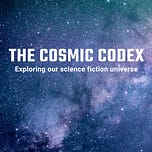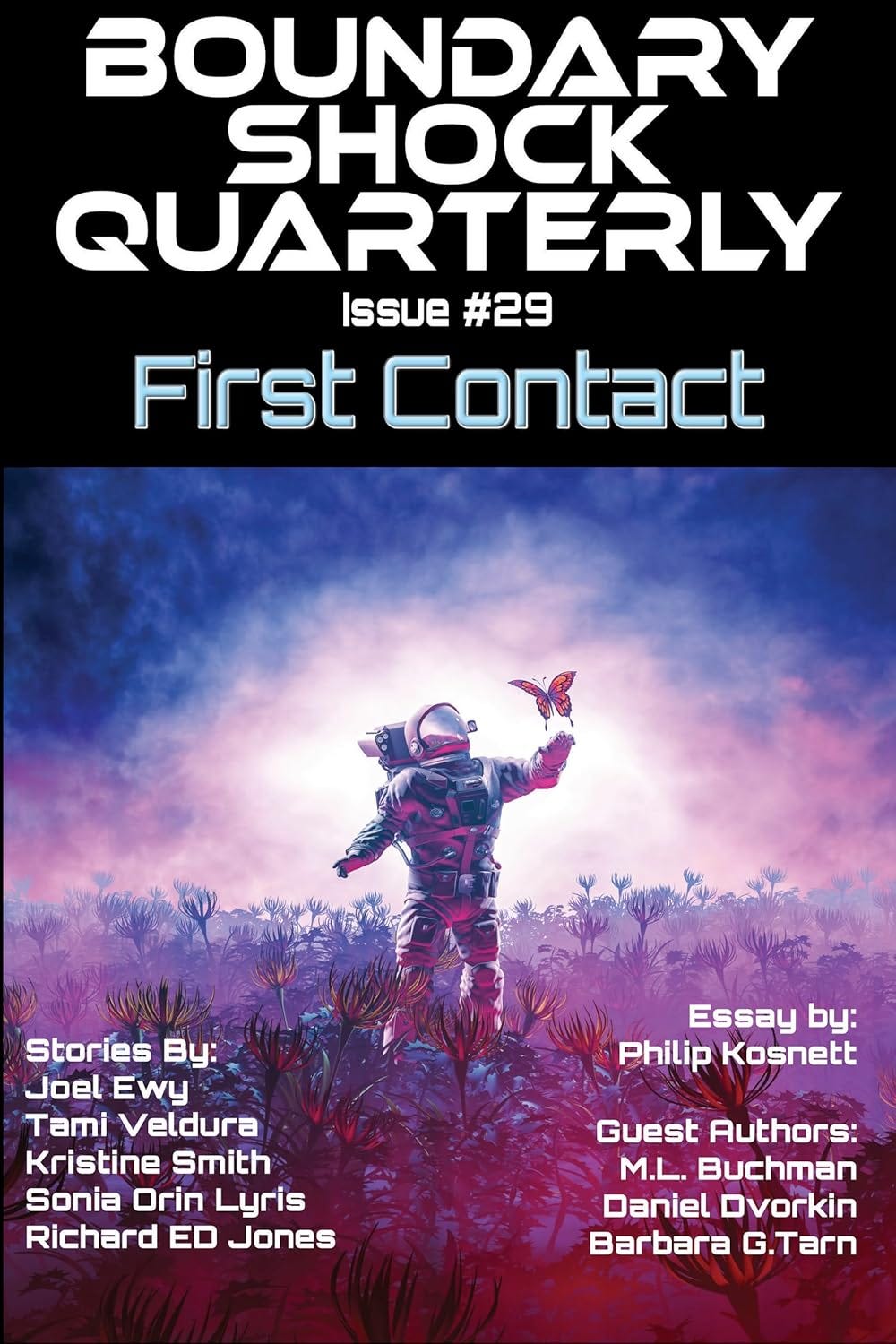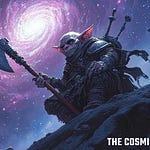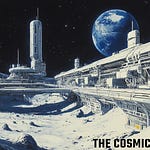My novelette, An Illicit Mercy, is part of a new promotion in March and April: Expect the Unexpected: Fantasy and Science Fiction with Unusual Plot Twists!
Over fifty short stories, novels, samples and excerpts, available at no cost.
Maddie is the NPC with attitude!
Buy a copy of Desert Runner by Dawn Chapman!
Plagued by old injuries that won't heal, she's enticed into accepting a deadly escort mission.
Of course, it's to cross the damned desert... and in the middle of Tromoal breeding season, no less. But the lure of enough cash to fix herself up and help out a close friend, too...? That's a siren's song she can't ignore.
Puatera Online is a harsh world, even for the people who have to live there.
Good thing Maddie is tougher than cured leather, because she may have just bitten off more than she can chew.
How is gravity related to the other three fundamental forces?
By Brian Scott Pauls with the help of ChatGPT 4o
The fundamental forces of nature, and how they interact, form the basic subject matter of physics. As a result, many science fiction novels and short stories consider the behavior of one or more of these forces in unusual situations.
The Gods Themselves by Isaac Asimov (1972)
This novel explores themes of scientific discovery and cross-dimensional physics. The story revolves around the development of a device called the electron pump, which transfers matter between our universe and a parallel one to provide an inexhaustible energy source. However, this transfer destabilizes the strong nuclear force in our universe, threatening to destroy the Sun.
Dragon’s Egg by Robert L. Forward (1980)
Forward’s book imagines a neutron star as the setting for an alien civilization. The novel follows the development of intelligent life called the Cheela, who evolve on the surface of the collapsed star, where the gravity is billions of times stronger than on Earth. Life is possible in this environment due to “nuclei bound by the strong force, rather than…by the electromagnetic force.”
Long Leap by Derek Künsken (2012)
First published in On Spec magazine, this story tackles the idea of a metal planet orbiting within the magnetic fields of a pulsar. “Tetracarbonyl base…life forms” inhabit the planet’s surface, and “everything carries an electric charge, making the magnetic fields function almost like cell membranes.”
The Problem of Gravity
Gravity is one of the four fundamental forces, alongside electromagnetism, the strong nuclear force, and the weak nuclear force. Yet, despite its pervasive influence on cosmic scales, gravity remains distinct from the other three, which are described by the Standard Model of particle physics. Understanding how gravity relates to these forces has been a longstanding scientific challenge.
The Standard Model and General Relativity
The Standard Model details the three non-gravitational forces in terms of quantum field theory. They are mediated by particles: photons for electromagnetism, W and Z bosons for the weak force, and gluons for the strong force. The forces operate within the framework of quantum mechanics, which governs the behavior of particles at atomic and subatomic scales.
Gravity, on the other hand, is described by Einstein's General Theory of Relativity. General relativity views gravity not as a force mediated by particles but as the curvature of spacetime caused by mass and energy. This classical framework successfully explains gravitational phenomena from planetary orbits to black holes but does not align with the quantum description of the other forces.
While the Standard Model has achieved remarkable success in describing particle interactions, it does not include gravity. Conversely, general relativity does not incorporate quantum mechanics. Bridging this divide requires a theory of quantum gravity, which remains elusive.
String Theory
String theory is one of the most prominent approaches to unifying gravity with the other fundamental forces. It posits that the basic building blocks of the universe are not point-like particles but one-dimensional strings vibrating at different frequencies. These vibrations determine the properties of particles, such as mass and charge.
A key feature of string theory is that it naturally incorporates a massless, spin-2 particle resembling the graviton, the hypothetical quantum mediator of gravity. It therefore offers a framework in which gravity can be described quantum mechanically.
Moreover, string theory is inherently compatible with the other forces described by the Standard Model. It requires additional dimensions of spacetime—typically 10 or 11—to function mathematically, which has led to predictions about hidden dimensions that could even explain dark matter.
However, string theory faces challenges. It has not yet produced testable predictions that distinguish it from other theories, and its reliance on higher dimensions has raised questions about its physical relevance. Despite these issues, it remains a leading candidate for a unified theory.
Loop Quantum Gravity
Loop quantum gravity (LQG) takes a different approach to integrating gravity with quantum mechanics. Instead of introducing new dimensions or particles, LQG applies quantum principles directly to the spacetime fabric described by general relativity. In LQG, spacetime is quantized, consisting of discrete units called "quantum loops."
These loops form a network, or "spin network," that evolves over time. This quantization avoids cosmological singularities, such as those found in black holes and the Big Bang, and provides a framework for describing gravity at the Planck scale.
LQG has achieved some successes, such as resolving certain black hole singularities and predicting a "big bounce" scenario instead of a Big Bang singularity. However, it does not incorporate the other three forces described by the Standard Model, limiting its scope as a unification theory. Additionally, like string theory, LQG has yet to make definitive testable predictions.
Grand Unified Theories
Grand Unified Theories (GUTs) aim to unify electromagnetism, the weak force, and the strong force within a single framework. These theories propose that at high energy scales, such as those present in the early universe, these forces merge into a single force. Examples include SU(5) and SO(10) models, which describe particles and forces in terms of larger symmetry groups.
While GUTs do not include gravity, they are often considered a stepping stone toward a Theory of Everything that incorporates all four forces. One potential route is to embed GUTs within string theory, leveraging its capacity to include gravity. However, the energy scales at which GUTs operate are far beyond the reach of current experiments, making direct testing difficult.
Supersymmetry and Supergravity
Supersymmetry (SUSY) is a theoretical framework that extends the Standard Model by positing a symmetry between fermions (matter particles) and bosons (force carriers). Each particle has a superpartner with different spin properties. SUSY has been motivated by its ability to solve several theoretical issues, such as stabilizing the Higgs boson's mass.
When combined with gravity, supersymmetry leads to supergravity, a theory that extends general relativity by incorporating quantum fields. Supergravity can be seen as a low-energy limit of string theory and provides a link between quantum mechanics and gravity. However, like string theory, supersymmetry and supergravity have yet to find experimental confirmation.
Emergent Gravity
An alternative perspective suggests that gravity might not be a fundamental force but an emergent phenomenon. In this view, gravity arises from the collective behavior of more fundamental entities, much like temperature emerges from the motion of particles.
One prominent example is Erik Verlinde's entropic gravity, which derives gravity as an emergent force related to changes in entropy. This idea has sparked interest for its novel approach but remains speculative and requires further development to connect with quantum mechanics and the Standard Model.
Challenges and Future Directions
Unifying gravity with the other fundamental forces faces numerous challenges. Experimentally, the energy scales at which quantum gravitational effects become significant—the Planck scale—are far beyond the reach of current technology. This limits our ability to test theories like string theory or LQG.
Theoretically, the mathematical complexity of these frameworks and their reliance on assumptions, such as extra dimensions or supersymmetric particles, present significant hurdles. Moreover, any successful theory must reduce to both general relativity and the Standard Model in their respective domains of validity, a requirement that many proposals struggle to meet.
Recent advances in observational astronomy and experimental physics offer new avenues for testing these theories. For instance, gravitational wave observations, high-precision tests of general relativity, and searches for new particles at the Large Hadron Collider provide potential insights.
The quest to unify gravity with the other fundamental forces remains one of the most profound challenges in physics. Theories such as string theory, loop quantum gravity, and emergent gravity offer promising frameworks but face significant experimental and theoretical obstacles. Advances in technology and a deeper understanding of fundamental physics will be crucial in resolving this puzzle.
While a definitive answer remains elusive, the pursuit of unification has deepened our understanding of the universe, inspiring new ideas and pushing the boundaries of human knowledge. As we continue to explore the nature of reality, the integration of gravity with the other forces will remain a central goal in the quest for a Theory of Everything.
Story Concepts
Our ignorance of how gravity is related to the other three fundamental forces may frustrate scientists, but presents science fiction writers with great opportunities. The lack of answers opens up many possibilities to tell new and exciting stories, such as:
“The Fifth Bridge”
After humanity develops a unified theory linking gravity with electromagnetism, a group of rogue scientists creates "Graviton Bridges," wormhole-like portals powered by the manipulation of gravitational waves and electromagnetic fields. These bridges allow instantaneous travel across vast distances. However, when the bridges begin to destabilize local spacetime, the team discovers that their creations are triggering quantum fluctuations in the fabric of reality, threatening the delicate balance of the Cosmos. The protagonists must uncover the deeper relationship between gravity and the other forces, revealing a hidden "fifth force" that governs universal coherence.
“The Strong Gravity Experiment”
Set in a near-future particle accelerator lab, researchers experimenting with the unification of gravity and the strong nuclear force accidentally create micro black holes that mimic the conditions of the early universe. These black holes emit bursts of particles bound by both gravity and strong interactions, which defy known physical laws. The anomalies lead the team to discover that gravity is a "shadow force," influenced by higher-dimensional particles tied to the strong force. As the team races to harness this connection, they realize they’ve unlocked the key to stellar engineering. And if they go public, they’ll hand the world the ultimate weapon of mass destruction.
“Quantum Magnetism and the Gravitic Resonance”
In a society powered by quantum technologies, researchers discover a way to combine gravity with the weak nuclear force by tuning into "gravitic resonance frequencies" that connect subatomic particles with spacetime itself. This breakthrough creates "quantum magnetic fields" that can manipulate planetary orbits or stabilize collapsing stars. However, the discovery attracts the attention of an alien civilization that uses gravitic resonance as the basis for their advanced technology. They see humanity’s experiments as reckless and demand the immediate cessation of all research—or they’ll demonstrate the catastrophic consequences of misaligning the forces. Humanity must negotiate with the aliens while navigating the moral and existential challenges of wielding such power.
We may discover answers to the questions posed above tomorrow or centuries from now. Either way, speculation about how the fundamental forces might interact provides fertile ground for the human imagination.
Do you have a favorite novel or short story where the relationships between the fundamental physical forces play an important role? Please share below!















